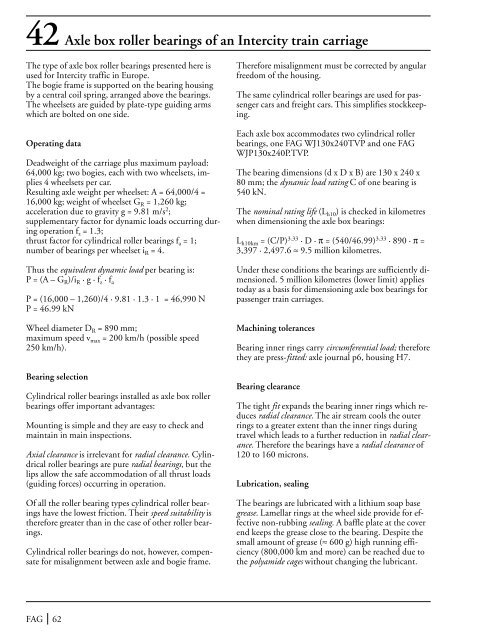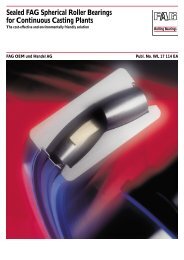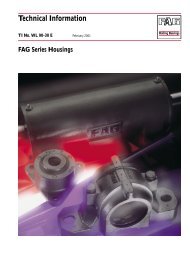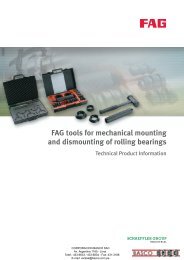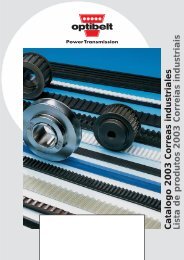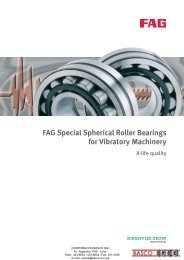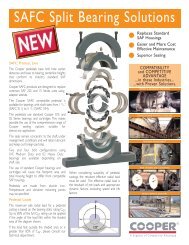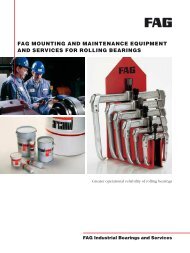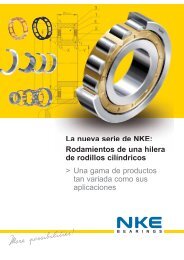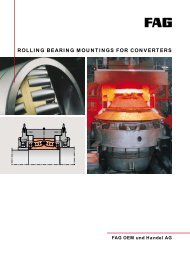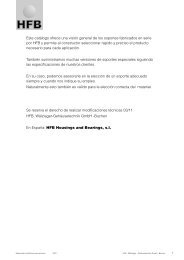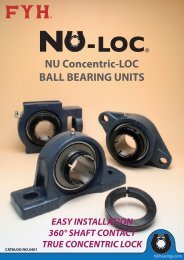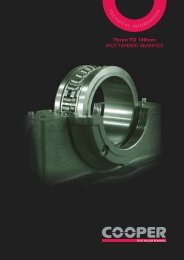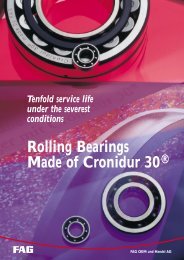Create successful ePaper yourself
Turn your PDF publications into a flip-book with our unique Google optimized e-Paper software.
42 Axle box roller bearings <strong>of</strong> an Intercity train carriage<strong>The</strong> type <strong>of</strong> axle box roller bearings presented here isused for Intercity traffic in Europe.<strong>The</strong> bogie frame is supported on the bearing housingby a central coil spring, arranged above the bearings.<strong>The</strong> wheelsets are guided by plate-type guiding armswhich are bolted on one side.Operating dataDeadweight <strong>of</strong> the carriage plus maximum payload:64,000 kg; two bogies, each with two wheelsets, implies4 wheelsets per car.Resulting axle weight per wheelset: A = 64,000/4 =16,000 kg; weight <strong>of</strong> wheelset G R = 1,260 kg;acceleration due to gravity g = 9.81 m/s 2 ;supplementary factor for dynamic loads occurring duringoperation f z = 1.3;thrust factor for cylindrical roller bearings f a = 1;number <strong>of</strong> bearings per wheelset i R = 4.Thus the equivalent dynamic load per bearing is:P = (A – G R )/i R · g · f z · f aP = (16,000 – 1,260)/4 · 9.81 · 1.3 · 1 = 46,990 NP = 46.99 kNWheel diameter D R = 890 mm;maximum speed v max = 200 km/h (possible speed250 km/h).<strong>Bearing</strong> selectionCylindrical roller bearings installed as axle box rollerbearings <strong>of</strong>fer important advantages:Mounting is simple and they are easy to check andmaintain in main inspections.Axial clearance is irrelevant for radial clearance. Cylindricalroller bearings are pure radial bearings, but thelips allow the safe accommodation <strong>of</strong> all thrust loads(guiding forces) occurring in operation.Of all the roller bearing types cylindrical roller bearingshave the lowest friction. <strong>The</strong>ir speed suitability istherefore greater than in the case <strong>of</strong> other roller bearings.Cylindrical roller bearings do not, however, compensatefor misalignment between axle and bogie frame.<strong>The</strong>refore misalignment must be corrected by angularfreedom <strong>of</strong> the housing.<strong>The</strong> same cylindrical roller bearings are used for passengercars and freight cars. This simplifies stockkeeping.Each axle box accommodates two cylindrical rollerbearings, one FAG WJ130x240TVP and one FAGWJP130x240P.TVP.<strong>The</strong> bearing dimensions (d x D x B) are 130 x 240 x80 mm; the dynamic load rating C <strong>of</strong> one bearing is540 kN.<strong>The</strong> nominal rating life (L h10 ) is checked in kilometreswhen dimensioning the axle box bearings:L h10km = (C/P) 3.33 · D · π = (540/46.99) 3.33 · 890 · π =3,397 · 2,497.6 ≈ 9.5 million kilometres.Under these conditions the bearings are sufficiently dimensioned.5 million kilometres (lower limit) appliestoday as a basis for dimensioning axle box bearings forpassenger train carriages.Machining tolerances<strong>Bearing</strong> inner rings carry circumferential load; thereforethey are press-fitted: axle journal p6, housing H7.<strong>Bearing</strong> clearance<strong>The</strong> tight fit expands the bearing inner rings which reducesradial clearance. <strong>The</strong> air stream cools the outerrings to a greater extent than the inner rings duringtravel which leads to a further reduction in radial clearance.<strong>The</strong>refore the bearings have a radial clearance <strong>of</strong>120 to 160 microns.Lubrication, sealing<strong>The</strong> bearings are lubricated with a lithium soap basegrease. Lamellar rings at the wheel side provide for effectivenon-rubbing sealing. A baffle plate at the coverend keeps the grease close to the bearing. Despite thesmall amount <strong>of</strong> grease (≈ 600 g) high running efficiency(800,000 km and more) can be reached due tothe polyamide cages without changing the lubricant.FAG 62


